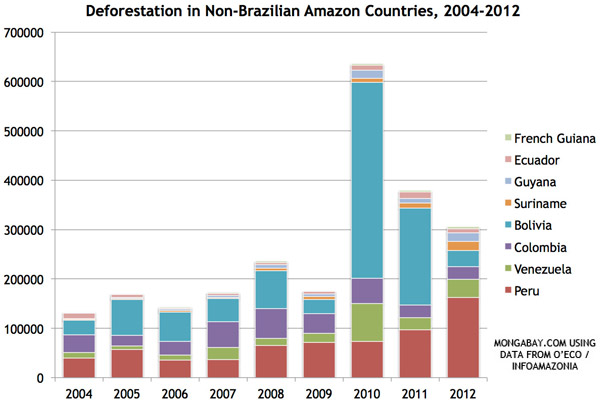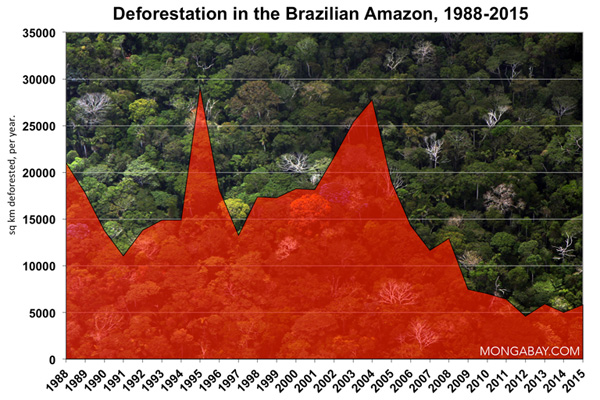Deforestation rising in non-Brazilian Amazon countries
Editors note (7/7/13): Re-analysis of the original data has led to revision of the annual forest loss data.
Deforestation has sharply increased in Amazon rainforest countries outside of Brazil, finds a new analysis based on satellite data.
Researchers from Terra-i and O-Eco’s InfoAmazonia team have developed updated forest cover maps for Bolivia, Colombia, Ecuador, Guyana, French Guyana, Peru, Suriname and Venezuela. The results reveal an increasing trend in forest clearing since 2004.
Peru had the largest extent of forest loss in 2012, losing 162,000 hectares, an increase of 65,000 ha or 67 percent over 2011. Venezuela (12,600 ha), Suriname (8,506 ha), and Guyana (6,981 ha) followed. In terms of percentage change, Suriname (84 percent) and Guyana (69 percent) had the largest rate of increase over the period. Bolivia saw an 83 percent decrease in deforestation.


InfoAmazonia’s analysis also looked at deforestation at a subnational level, including states, departments, and municipalities as well as protected areas, indigenous reserves, and ecosystems. Loreto, Peru had the largest forest loss in 2012 — 25,544 ha. Caquetá, Colombia saw its deforestation rate jump 193 percent.
Among parks, Pacaya Samiria (3,325 ha) in Peru, Imataca (1,356 ha), the Upper Orinoco-Cassiquiare (819 ha) in Venezuela, and Noord Saramaccan (581 ha) in Suriname saw the highest forest loss. The Iquitos várzea — floodplain forest along the main stem of the Amazon — lost the largest area of forest among eco-regions both in 2012 (24,094 ha) and over the nine-year period (151,675 ha).
Indigenous areas, which covered 4.4 percent of the land area, accounted for 1.5 percent of forest loss detected between 2004 and 2012. By comparison, protected areas covered 19.9 percent of the area and accounted for 9.3 percent of deforestation. The results indicate that indigenous areas, adjusted for size, had a lower rate of forest loss than parks in the region.

Overall, the assessment found that the eight Amazon countries lost some 2.3 million ha of forest between 2004 and 2012. By comparison, Brazil, which was excluded from the study, lost 11.1 million hectares during the period. But Brazil’s deforestation rate is declining, falling from 2.7 million ha in 2004 to 465,600 ha in 2012. More than 60 percent of the Amazon rainforest lies within Brazil.

 Click images to enlarge
Click images to enlarge
Brazil’s drop in deforestation has been partly attributed to its development and implementation of a near real-time deforestation tracking system that alerts authorities of changes in forest cover, enabling them to take action shortly after or even during forest clearing. Terra-i’s system, which uses MODIS data from NASA’s Terra and Aqua satellites, now offers similar capabilities beyond the Brazilian Amazon.
Cattle ranching is the biggest direct driver of deforestation in the Amazon rainforest, accounting for more than 60 percent of clearing. Logging is the biggest factor in forest degradation.
Related articles
Brazil’s GHG emissions fall 39% since 2005, now 10% below 1990 levels
(06/06/2013) Brazil’s greenhouse-gas emissions dropped 39 percent between 2005 and 2010, largely due to a reduction in deforestation, reports an inventory released yesterday by the Brazilian government.
Brazil touts progress in reducing deforestation, but fails to note recent jump in clearing
(06/05/2013) Today in a press release for the U.N.’s World Environment Day, the Brazilian government highlighted a sharp drop in deforestation since 2012. The trouble is, the South American superpower failed to acknowledge what appears to be a sharp rise in Amazon forest loss since last year, reports Greenpeace.
Deforestation in the Brazilian Amazon pacing 88% higher than last year’s rate
(05/18/2013) Satellite analysis by a Brazil-based NGO indicates that deforestation in the Brazilian Amazon continues to pace well ahead of last year, when the government passed a weakened version of its law governing use of forest lands.
Deforestation will undercut effectiveness of rainforest dams

(05/13/2013) Deforestation may significantly decrease the hydroelectric potential of tropical rainforest regions, warns a new study published in Proceedings of the National Academy of Science. The study, used climate, hydrological, and land use models to forecast the impact of potential forest loss on hydropower generation on the Xingu River, a major tributary of the Amazon where the world’s third largest dam — Belo Monte — is currently under construction.
Continued deforestation in the Amazon may kill Brazil’s agricultural growth
(05/09/2013) Continuing deforestation in the Amazon rainforest could undermine agricultural productivity in the region by reducing rainfall and boosting temperatures, warns a new study published in the journal Environmental Research Letters.
Brazil’s satellite monitoring reduced Amazon deforestation by 60,000 sq km in 5 years
(05/08/2013) Brazil’s advanced satellite monitoring system, coupled with increased law enforcement, was responsible for nearly 60 percent of the 101,000 square kilometer-drop in deforestation observed between 2007 and 2011, argues a new study published an international think tank.







